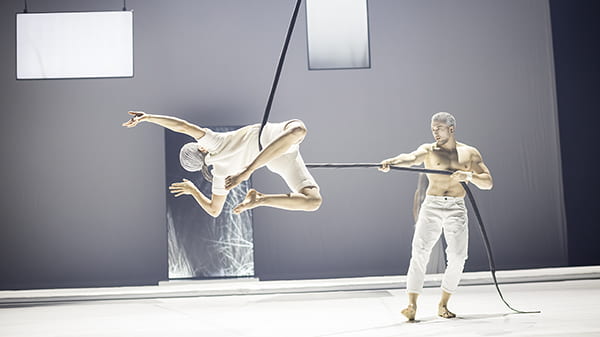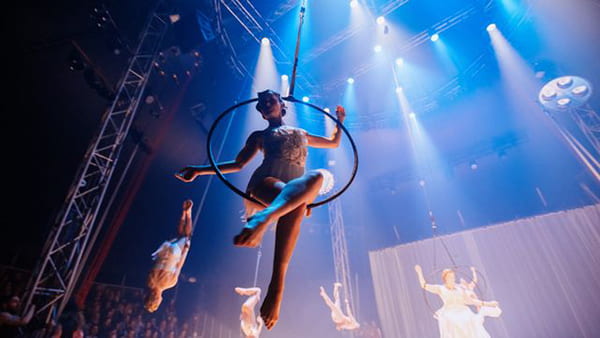It’s early evening and the National Theatre: The New Stage in Prague is sold out for the premiere show of Krajina těla or Land of Body. Sounds of waves crashing and a cello fill the hall as aerial acrobat Alžbeta Tichá climbs up a dangling rope, twisting, flipping, and falling dangerously fast before pulling the rope taut. While she moves through her choreography, eight LED screens placed around the stage show close-up images of hair follicles.
This is circus. Or, a kind of circus. With its understated exploration of physicality—a visual poem through movement—Krajina těla is an example of the experimental circus style emerging in the Czech Republic. Decidedly different from the theatrical and showy version of modern circus that Czech companies have mastered, the change comes as a new generation of performers enters the field, bringing with them new techniques and concepts.
Czech contemporary circus was created right after the fall of communism in 1989. “Metaphorical, symbolic—the circus as a physical form was there as a metaphor for something else. Like you are on the trapeze, so you are representing a bird, for example,” says Veronika Štefanová, research supervisor of CIRQUEON, a Prague-based circus center. Theatre folk were inspired by touring European circus companies, but, without formal training to make stand-alone circus shows, they began incorporating these elements into their theatre productions.
The style’s popularity exploded in 2004 with the annual summer festival, Letní Letná, started by Jiří Turek, who has a background in dancing, miming, and alternative theatre. When he first hosted the festival in Prague, there were 6,000 attendees. Now it attracts 60,000 people, making it the biggest contemporary circus festival in the Czech Republic. “We invite the biggest companies,” Turek says of his festival direction. “We must do it. The smaller festivals cannot invite them; it is too expensive.” The necessity of featuring large companies has developed a large, unvarying style of circus—commercial and theatrical.
Cirk La Putyka is a case in point. It is the latest company in Prague, currently performing Cesty, which features more than 50 performers in a classic circus top. The acrobats, dancers, and actors wear flashy costumes while thunderous sound effects accentuate the stunts. In one act nine women flip around Hula-Hoops spinning high in the air. In another, a man walks amid the audience seats and breathes out orange flames. These moments are interspersed with storytelling and dialogue. The show is a glamorous spectacle.
This “wow” factor is necessary, explains researcher Štefanová. “They would like to really live on circus and work only in circus, and it means you have to sell a lot of tickets.” Cirk La Putyka and other large companies have successfully done so, regularly selling out shows. In recent years the experimental shows have gained popularity with new techniques by younger artists. The kids, who 10 years ago signed up for informal circus classes at CIRQUEON, are of a professional age now. Tichá, the rope acrobat in Krajina těla, performs in several avant-garde shows. Along with Krajina těla, she is part of Thin Skin, a production staged in the DOX Centre for Contemporary Art.
Tichá emphasizes that she is not so much entertaining an audience as pushing the limits of her art, conducting a kind of research while onstage. “When I go on the rope, I have to be present. There is no chance to think about anything else.”
Repurposed and edited with permission by Dispatches

